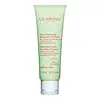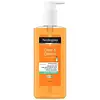What's inside
What's inside
 Key Ingredients
Key Ingredients

No key ingredients
 Benefits
Benefits

 Concerns
Concerns

 Ingredients Side-by-side
Ingredients Side-by-side

Water
Skin ConditioningSodium Cocoyl Isethionate
CleansingGlycerin
HumectantSodium Lauroyl Sarcosinate
CleansingSqualane
EmollientPropanediol
SolventGlycol Distearate
EmollientCoconut Acid
CleansingGlyceryl Behenate
EmollientDisodium Cocoyl Glutamate
CleansingC14-22 Alcohols
Emulsion StabilisingPolyacrylate Crosspolymer-6
Emulsion StabilisingSodium Isethionate
CleansingParfum
MaskingMannitol
HumectantButylene Glycol
HumectantSodium Citrate
BufferingSodium Cocoyl Glutamate
CleansingCellulose
AbsorbentChlorphenesin
AntimicrobialCitric Acid
BufferingC12-20 Alkyl Glucoside
EmulsifyingDisodium EDTA
CI 77007
Cosmetic ColorantSodium Salicylate
PreservativeMaltodextrin
AbsorbentMoringa Oleifera Seed Extract
Skin ConditioningSpiraea Ulmaria Extract
AstringentMelissa Officinalis Leaf Extract
Skin ConditioningT-Butyl Alcohol
PerfumingSaponaria Officinalis Leaf Extract
AntimicrobialAcrylates/Ammonium Methacrylate Copolymer
Triethyl Citrate
MaskingGentiana Lutea Extract
EmollientHydroxypropyl Methylcellulose
Emulsion StabilisingSodium Benzoate
MaskingPotassium Sorbate
PreservativeWater, Sodium Cocoyl Isethionate, Glycerin, Sodium Lauroyl Sarcosinate, Squalane, Propanediol, Glycol Distearate, Coconut Acid, Glyceryl Behenate, Disodium Cocoyl Glutamate, C14-22 Alcohols, Polyacrylate Crosspolymer-6, Sodium Isethionate, Parfum, Mannitol, Butylene Glycol, Sodium Citrate, Sodium Cocoyl Glutamate, Cellulose, Chlorphenesin, Citric Acid, C12-20 Alkyl Glucoside, Disodium EDTA, CI 77007, Sodium Salicylate, Maltodextrin, Moringa Oleifera Seed Extract, Spiraea Ulmaria Extract, Melissa Officinalis Leaf Extract, T-Butyl Alcohol, Saponaria Officinalis Leaf Extract, Acrylates/Ammonium Methacrylate Copolymer, Triethyl Citrate, Gentiana Lutea Extract, Hydroxypropyl Methylcellulose, Sodium Benzoate, Potassium Sorbate
Water
Skin ConditioningCocamidopropyl Hydroxysultaine
CleansingSodium Methyl Cocoyl Taurate
CleansingGlycerin
HumectantSalicylic Acid
MaskingSodium Hydrolyzed Potato Starch Dodecenylsuccinate
C12-15 Alkyl Lactate
EmollientPanthenol
Skin ConditioningCocamidopropyl Pg-Dimonium Chloride Phosphate
Disodium Tetrapropenyl Succinate
PEG-120 Methyl Glucose Dioleate
EmulsifyingSodium Chloride
MaskingDisodium EDTA
Citric Acid
BufferingSodium Hydroxide
BufferingTocopherol
AntioxidantBenzalkonium Chloride
AntimicrobialParfum
MaskingWater, Cocamidopropyl Hydroxysultaine, Sodium Methyl Cocoyl Taurate, Glycerin, Salicylic Acid, Sodium Hydrolyzed Potato Starch Dodecenylsuccinate, C12-15 Alkyl Lactate, Panthenol, Cocamidopropyl Pg-Dimonium Chloride Phosphate, Disodium Tetrapropenyl Succinate, PEG-120 Methyl Glucose Dioleate, Sodium Chloride, Disodium EDTA, Citric Acid, Sodium Hydroxide, Tocopherol, Benzalkonium Chloride, Parfum
 Reviews
Reviews

Ingredients Explained
These ingredients are found in both products.
Ingredients higher up in an ingredient list are typically present in a larger amount.
Citric Acid is an alpha hydroxy acid (AHA) naturally found in citrus fruits like oranges, lemons, and limes.
Like other AHAs, citric acid can exfoliate skin by breaking down the bonds that hold dead skin cells together. This helps reveal smoother and brighter skin underneath.
However, this exfoliating effect only happens at high concentrations (20%) which can be hard to find in cosmetic products.
Due to this, citric acid is usually included in small amounts as a pH adjuster. This helps keep products slightly more acidic and compatible with skin's natural pH.
In skincare formulas, citric acid can:
While it can provide some skin benefits, research shows lactic acid and glycolic acid are generally more effective and less irritating exfoliants.
Most citric acid used in skincare today is made by fermenting sugars (usually from molasses). This synthetic version is identical to the natural citrus form but easier to stabilize and use in formulations.
Read more about some other popular AHA's here:
Learn more about Citric AcidDisodium EDTA plays a role in making products more stable by aiding other preservatives.
It is a chelating agent, meaning it neutralizes metal ions that may be found in a product.
Disodium EDTA is a salt of edetic acid and is found to be safe in cosmetic ingredients.
Learn more about Disodium EDTAGlycerin is already naturally found in your skin. It helps moisturize and protect your skin.
A study from 2016 found glycerin to be more effective as a humectant than AHAs and hyaluronic acid.
As a humectant, it helps the skin stay hydrated by pulling moisture to your skin. The low molecular weight of glycerin allows it to pull moisture into the deeper layers of your skin.
Hydrated skin improves your skin barrier; Your skin barrier helps protect against irritants and bacteria.
Glycerin has also been found to have antimicrobial and antiviral properties. Due to these properties, glycerin is often used in wound and burn treatments.
In cosmetics, glycerin is usually derived from plants such as soybean or palm. However, it can also be sourced from animals, such as tallow or animal fat.
This ingredient is organic, colorless, odorless, and non-toxic.
Glycerin is the name for this ingredient in American English. British English uses Glycerol/Glycerine.
Learn more about GlycerinParfum is a catch-all term for an ingredient or more that is used to give a scent to products.
Also called "fragrance", this ingredient can be a blend of hundreds of chemicals or plant oils. This means every product with "fragrance" or "parfum" in the ingredients list is a different mixture.
For instance, Habanolide is a proprietary trade name for a specific aroma chemical. When used as a fragrance ingredient in cosmetics, most aroma chemicals fall under the broad labeling category of “FRAGRANCE” or “PARFUM” according to EU and US regulations.
The term 'parfum' or 'fragrance' is not regulated in many countries. In many cases, it is up to the brand to define this term.
For instance, many brands choose to label themselves as "fragrance-free" because they are not using synthetic fragrances. However, their products may still contain ingredients such as essential oils that are considered a fragrance by INCI standards.
One example is Calendula flower extract. Calendula is an essential oil that still imparts a scent or 'fragrance'.
Depending on the blend, the ingredients in the mixture can cause allergies and sensitivities on the skin. Some ingredients that are known EU allergens include linalool and citronellol.
Parfum can also be used to mask or cover an unpleasant scent.
The bottom line is: not all fragrances/parfum/ingredients are created equally. If you are worried about fragrances, we recommend taking a closer look at an ingredient. And of course, we always recommend speaking with a professional.
Learn more about ParfumWater. It's the most common cosmetic ingredient of all. You'll usually see it at the top of ingredient lists, meaning that it makes up the largest part of the product.
So why is it so popular? Water most often acts as a solvent - this means that it helps dissolve other ingredients into the formulation.
You'll also recognize water as that liquid we all need to stay alive. If you see this, drink a glass of water. Stay hydrated!
Learn more about Water